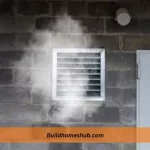The roof is arguably one of the most important parts of a building, providing protection from the elements and ensuring the safety and comfort of those inside. Proper installation of a roof requires the use of various materials and tools, including roofing nails. However, using these nails correctly is essential to avoid damaging the roof or compromising its structural integrity.
One question that often arises is whether roofing nails are supposed to go through the roof. In this article, we’ll delve deeper into this topic and explore the proper use of roofing nails in roofing projects.
Should Roofing Nails Go Through?
Roofing nails should go through the shingles and into the roof deck, but they should not penetrate the deck completely. When installed properly, roofing nails should be driven in just enough to securely fasten the shingles to the roof deck without puncturing through the other side. This is important because if the nails go all the way through the deck, they can create holes in the roof, allowing water to seep in and potentially causing damage to the underlying structure.
On the other hand, if the nails are not driven in far enough, the shingles may not be securely fastened to the roof, and they could be susceptible to wind damage or even blow off during a storm. Therefore, it’s crucial to follow proper installation procedures when using roofing nails to ensure the longevity and effectiveness of your roofing system.
Types of Roofing Nails
Roofing nails are designed specifically for use in roofing applications and are made of materials that are resistant to rust and corrosion. There are several types of roofing nails available, each with its own unique features and benefits. The followings are some common types of roofing nails and their uses:
1. Standard roofing nails
These are the most common type of roofing nails and are often used with asphalt shingles. They have a large head that provides a secure grip on the shingle and a smooth shank that makes it easier to drive them into the wood substrate.
2. Coil roofing nails
These nails are used with pneumatic nail guns and are designed for high-speed roofing applications. They come in coils of 120 to 720 nails and can be made of galvanized or stainless steel.
3. Ring shank roofing nails
These nails have a series of rings around the shank that provide extra grip and help to prevent the nail from pulling out of the roofing material. They are often used with wood or composite shingles.
4. Cap nails
These nails have a large, round head that is designed to hold down roofing felt or underlayment. They are often used in low-slope roofing applications.
5. Copper roofing nails
These nails are often used in slate or tile roofing applications. Copper is resistant to corrosion and will not react with the roofing material, which helps to prevent damage to the roof over time.
When choosing the right type of roofing nail, consider the roofing material being used, as well as the specific application. Different roofing materials may require different types of nails in order to achieve the best possible results. It’s also important to consider factors such as corrosion resistance, ease of installation, and durability when selecting roofing nails for a particular job.
Correct Nailing Patterns for Roofing
When it comes to installing roofing materials, proper nailing patterns are essential for ensuring that the roof is secure and can withstand various weather conditions. Different types of roofing materials require different nailing patterns, so it’s important to follow manufacturer recommendations to ensure the roof is installed correctly.
1. Shingles
For asphalt shingles, the typical nailing pattern is to place nails above the laminated portion of the shingle, about 3/4 inch from the edge. The next shingle layer should cover the nails, creating a double layer of protection. The nails should be placed in a staggered pattern, with four nails per shingle for standard shingles and six nails per shingle for high-wind areas.
2. Tiles
When installing tiles, the nailing pattern will depend on the type of tile being used. Flat tiles typically require two nails near the top of the tile, while interlocking tiles may require additional nails. The spacing between nails should be determined by the tile manufacturer and will vary depending on the wind zone where the roof is being installed.
3. Metal panels
When installing metal roofing panels, the nailing pattern will depend on the type of panel being used. Corrugated panels, for example, typically require nails to be placed through the ridges of the panel, while standing seam panels require hidden fasteners. The spacing between nails will also vary depending on the panel and the wind zone where the roof is being installed.
Guideline for Correct Nail Placement
Proper nail placement is crucial for the overall strength and durability of a roof. Here are some guidelines for placing nails correctly:
1. Distance from the edge
When placing nails, it’s important to keep a sufficient distance from the edge of the roofing material. This distance will depend on the type of material being used, so it’s important to refer to the manufacturer’s instructions. In general, nails should be placed at least 3/4 inch from the edge of asphalt shingles and at least 1 inch from the edge of wood shingles or shakes.
2. Angle of the nail
Nails should be driven straight into the roofing material, perpendicular to the surface. If a nail is driven in at an angle, it can weaken the material and allow water to seep in. The angle of the nail should not exceed 15 degrees from vertical.
3. Overdriving and underdriving nails
Overdriving nails can cause the shingle or roofing material to be compressed, leading to cracking and splitting. On the other hand, underdriving nails can cause the shingle or material to lift, creating a weak spot in the roof that can be vulnerable to wind damage. Nails should be driven in so that the head is flush with the surface of the roofing material, without compressing or lifting it.
Common Mistakes When Installing Roofing Nails
When installing roofing nails, there are several common mistakes that people make. Here are some of the most frequent mistakes and their consequences:
1. Using the wrong type of nail
Different roofing materials require different types of nails. For example, if you use roofing nails that are not designed for the specific material you are installing, it can lead to nails popping out or the material not being properly secured. This can cause leaks and potentially compromise the entire roofing system.
2. Not using enough nails
Roofing manufacturers provide specific guidelines on how many nails should be used per shingle or tile. If you don’t use enough nails, it can cause the material to become loose or lift up during high winds, exposing the roof to the elements and leading to leaks and damage.
3. Overdriving or underdriving nails
If you use a nail gun or hammer improperly, it can lead to overdriving or underdriving the nail. Overdriving the nail can damage the material and potentially cause leaks while underdriving the nail can lead to the material not being properly secured, which can lead to it coming loose during high winds.
4. Incorrect nail placement
The placement of nails is crucial to the proper installation of roofing materials. If you place the nails too high or too low on the shingle or tile, it can cause the material to become loose or lift up during high winds, leading to leaks and damage.
5. Improper spacing of nails
Manufacturers provide specific guidelines for the spacing of nails, and not following these guidelines can lead to the roofing material not being properly secured. This can lead to the material becoming loose during high winds, leading to leaks and damage.
Final Thoughts
Roofing nails are supposed to go through the roof, but only to a certain extent. The nails should be driven in just far enough to securely fasten the shingle to the roof deck without puncturing through the other side. Proper installation of roofing nails is critical for the longevity and overall effectiveness of your roofing system. By following the proper procedures for using roofing nails, you can ensure that your roof will be strong, durable, and long-lasting.
I like to think I can help you with all the information you need on home renovations and DIY tips. You should subscribe.











